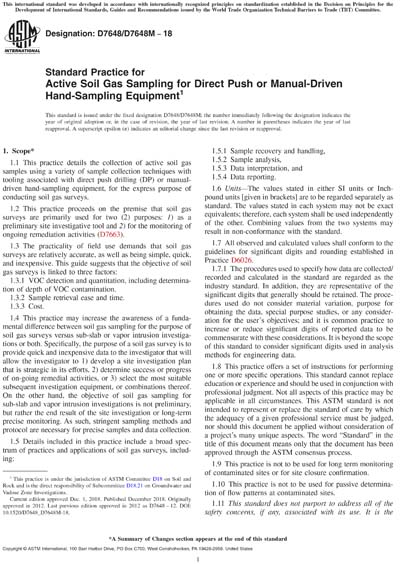Most recent
ASTM D7648/D7648M-18
Standard Practice for Active Soil Gas Sampling for Direct Push or Manual-Driven Hand-Sampling Equipment
1.1 This practice details the collection of active soil gas samples using a variety of sample collection techniques with tooling associated with direct push drilling (DP) or manual-driven hand-sampling equipment, for the express purpose of conducting soil gas surveys.
1.2 This practice proceeds on the premise that soil gas surveys are primarily used for two (2) purposes: 1) as a preliminary site investigative tool and 2) for the monitoring of ongoing remediation activities (D7663).
1.3 The practicality of field use demands that soil gas surveys are relatively accurate, as well as being simple, quick, and inexpensive. This guide suggests that the objective of soil gas surveys is linked to three factors:
1.3.1 VOC detection and quantitation, including determination of depth of VOC contamination.
1.3.2 Sample retrieval ease and time.
1.3.3 Cost.
1.4 This practice may increase the awareness of a fundamental difference between soil gas sampling for the purpose of soil gas surveys versus sub-slab or vapor intrusion investigations or both. Specifically, the purpose of a soil gas survey is to provide quick and inexpensive data to the investigator that will allow the investigator to 1) develop a site investigation plan that is strategic in its efforts, 2) determine success or progress of on-going remedial activities, or 3) select the most suitable subsequent investigation equipment, or combinations thereof. On the other hand, the objective of soil gas sampling for sub-slab and vapor intrusion investigations is not preliminary, but rather the end result of the site investigation or long-term precise monitoring. As such, stringent sampling methods and protocol are necessary for precise samples and data collection.
1.5 Details included in this practice include a broad spectrum of practices and applications of soil gas surveys, including:
1.5.1 Sample recovery and handling,
1.5.2 Sample analysis,
1.5.3 Data interpretation, and
1.5.4 Data reporting.
1.6 Units—The values stated in either SI units or Inch-pound units [given in brackets] are to be regarded separately as standard. The values stated in each system may not be exact equivalents; therefore, each system shall be used independently of the other. Combining values from the two systems may result in non-conformance with the standard.
1.7 All observed and calculated values shall conform to the guidelines for significant digits and rounding established in Practice D6026.
1.7.1 The procedures used to specify how data are collected/recorded and calculated in the standard are regarded as the industry standard. In addition, they are representative of the significant digits that generally should be retained. The procedures used do not consider material variation, purpose for obtaining the data, special purpose studies, or any consideration for the user’s objectives; and it is common practice to increase or reduce significant digits of reported data to be commensurate with these considerations. It is beyond the scope of this standard to consider significant digits used in analysis methods for engineering data.
1.8 This practice offers a set of instructions for performing one or more specific operations. This standard cannot replace education or experience and should be used in conjunction with professional judgment. Not all aspects of this practice may be applicable in all circumstances. This ASTM standard is not intended to represent or replace the standard of care by which the adequacy of a given professional service must be judged, nor should this document be applied without consideration of a project’s many unique aspects. The word “Standard” in the title of this document means only that the document has been approved through the ASTM consensus process.
1.9 This practice is not to be used for long term monitoring of contaminated sites or for site closure confirmation.
1.10 This practice is not to be used for passive determination of flow patterns at contaminated sites.
1.11 This standard does not purport to address all of the safety concerns, if any, associated with its use. It is the responsibility of the user of this standard to establish appropriate safety, health, and environmental practices and determine the applicability of regulatory limitations prior to use.
1.12 This practice does not purport to set standard levels of acceptable risk. Use of this practice for purposes of risk assessment is wholly the responsibility of the user.
1.13 Concerns of practitioner liability or protection from or release from such liability, or both, are not addressed by this practice.
1.14 This international standard was developed in accordance with internationally recognized principles on standardization established in the Decision on Principles for the Development of International Standards, Guides and Recommendations issued by the World Trade Organization Technical Barriers to Trade (TBT) Committee.
Content Provider
ASTM International [astm]






